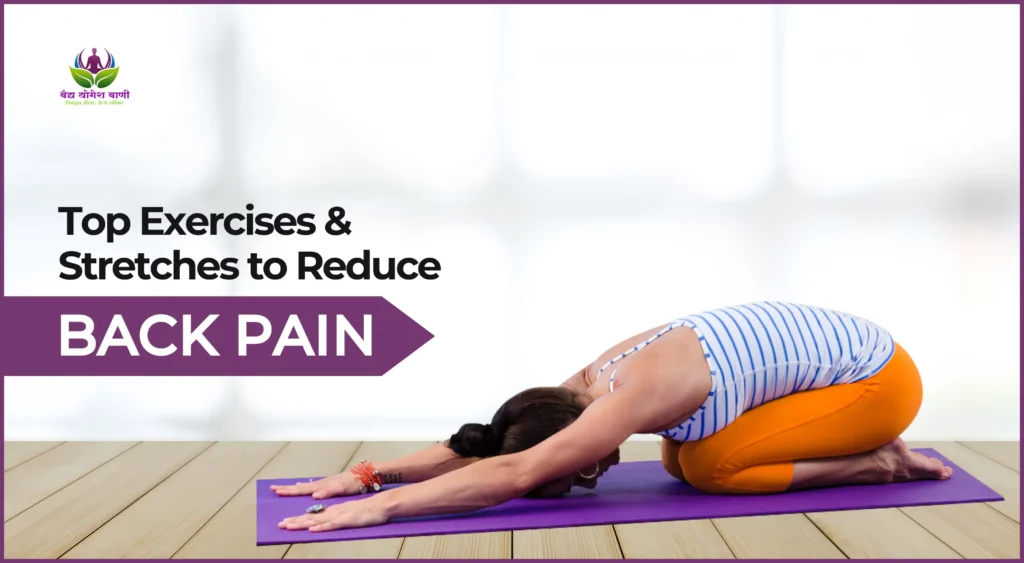Table of Contents
ToggleBack pain is a very common problem affecting individuals of all ages. It can interfere with sitting, standing, or even sleeping well. But the wonderful thing is that gentle movement can bring relief. Stretching and strengthening the right muscles can improve flexibility. This guide shares great stretches and exercises to ease back pain treatment. You can do them at home without risk and with ease. You need no equipment, just a little time every day. These exercises are for everyone. They relax tight muscles, improve posture, and support spine health. With practice, one will be able to have a happy back with lots of energy to do all other activities.
Why Do We Have Back Pain
The back has lots of pieces: bones, muscles, and soft joints. The back hurts when we sit for much of the day, play in an unbalanced manner, or pick up heavy weights. The result of this process causes muscles to become stiff while creating soreness in the body. By performing the right stretches along with proper movements, you can achieve better sensations in your back. Developing stronger muscles through conditioning exercises will decrease your lower back pain. It also supports spinal movements. Here are the top exercises & stretches to reduce back pain:
Child’s Pose
The child’s pose is among the most calming back stretches available to individuals. This position extends the tightness throughout your lower spinal area while calming your entire body. This position simultaneously extends the muscles in your hips, together with your shoulders, which benefits those who spend extended periods standing or sitting. Some use it as a resting pose during exercise because it feels so secure and soothing for the whole body. Here are the steps in detail:
- Kneel on the floor.
- Sit back on your heels.
- The floor should receive your forehead as you lean forward with gentle pressure.
- The stretch requires moving your arms either forward or placing them along your sides.
- Take deep breaths while maintaining the position for twenty to thirty seconds.
- You should conduct the process two to three times.
Knee-to-Chest Stretch
Stretching knees to chest using this basic approach helps relax lower back muscles. It eases pressure on the spine. It can also relax back muscles after sitting or standing for a long time. This also stretches the hips and consolidates circulation to the back. It is safe and simple for most people, making it the best choice in daily back care. Here are the steps in detail:
- Lie on your back with knees bent and feet flat.
- Gently pull one knee toward your chest.
- Hold for fifteen to twenty seconds.
- Repeat on the other side.
- You can also pull both knees toward your chest at the same time.
- Do this two or three times per leg.
Pelvic Tilt
Pelvic tilts are small movements that pack a punch. A beginner-level exercise exists that develops lower-body stability. Pelvic tilting exercises help reduce stiffness. They also lower the chances of future back pain. Here are the steps in detail:
- Lie down on your back while flexing your knees and keeping your feet flat on the surface.
- Contract the abdominal muscles, ensuring a gentle pressure of the lower back on the floor.
- Hold the position for about five seconds and then relax.
- Repeat slowly another 10 times.
Seated Hamstring Stretch
The sitting hamstring stretch targets the muscles behind your legs. These muscles are closely linked to your lower back. This move helps maintain good posture. It also makes bending and walking easier throughout the day. Here are the steps in detail:
- Put one leg straight out
- Bend the other leg, and the foot touches the inner thigh.
- Gently reach out toward the straight leg without forcing a stretch.
- Hold for 20 seconds.
- Switch the legs and repeat the steps.
Wall-Slide
Wall slides are simple and effective exercises to maintain good posture and strengthen the upper back. They keep the shoulders open and spine properly aligned for the benefit of back and neck pain. This exercise also develops awareness of correct standing posture so that standing becomes easier during the day. Here are the steps in detail:
- Stand with your back flat against the wall.
- Keep the feet slightly away from the wall.
- Place both arms in a goalpost position against the wall.
- Slide the arms up slowly and then back down.
- Repeat 10 times with control.
Bridge Pose
The bridge pose primarily develops the strength of muscles located in the lower back region as well as the core and glute muscles. This pose expands the chest and spine areas for better posture maintenance. The method works to strengthen the muscles that stabilize the back. It lets you do daily activities without pain. It boosts flexibility and reduces the risk of back pain when done regularly. Here are the steps in detail:
- Lie down on your back, keeping your knees bent and feet flat.
- Push into your feet and slowly raise your hips toward the ceiling.
- Keep your shoulders and arms down on the floor.
- Hold for ten to fifteen seconds.
- Slowly lower your hips back down.
- Repeat the lift five times.
Standing Back Extension
Standing back extensions are quick and easy. They help relieve tension from sitting too long or bending. They stretch the front of the body. It keeps your spine healthy and prevents stiffness. Here are the steps in detail:
- Stand with your feet hip-width apart.
- Place your hands on the lower back to support it.
- Gently lean backward without forcing the movement.
- Look up slightly if comfortable.
- Hold for five seconds and come to the stand again.
- Repeat this movement five times.
Conclusion
Caring for your back shouldn’t feel uncomfortable or like a chore. The best stretches for back pain do two things: they strengthen muscles and boost flexibility. Basic movements help improve both your spinal condition and body alignment. The stretching is both safe and easy. The stretches need no special equipment because you can perform them at home. A few minutes of daily practice will prove enough for your back health. Through regular practice, your body will experience significant pain reduction. Your body needs slow movement. Practice deep breathing with body awareness as you develop your movements. You’ll move better, feel less discomfort, and gain more self-confidence. For expert guidance, consult Dr. Yogesh Vani.
Frequently asked questions
Are these stretches safe for beginners?
How often should I rehearse these exercises for a backache?
The exercises can be performed twice daily during certain periods. Being consistent with your exercises holds more importance than the duration spent on each exercise.
How long will it be until I get results?
The majority of people notice their discomfort decreasing during their initial 48 hours, but consistent benefits start showing after performing these exercises each day for multiple weeks.
Will I require a few instruments to do these exercises?
No. A suitable workout area includes either carpeted floor space or a yoga mat.



